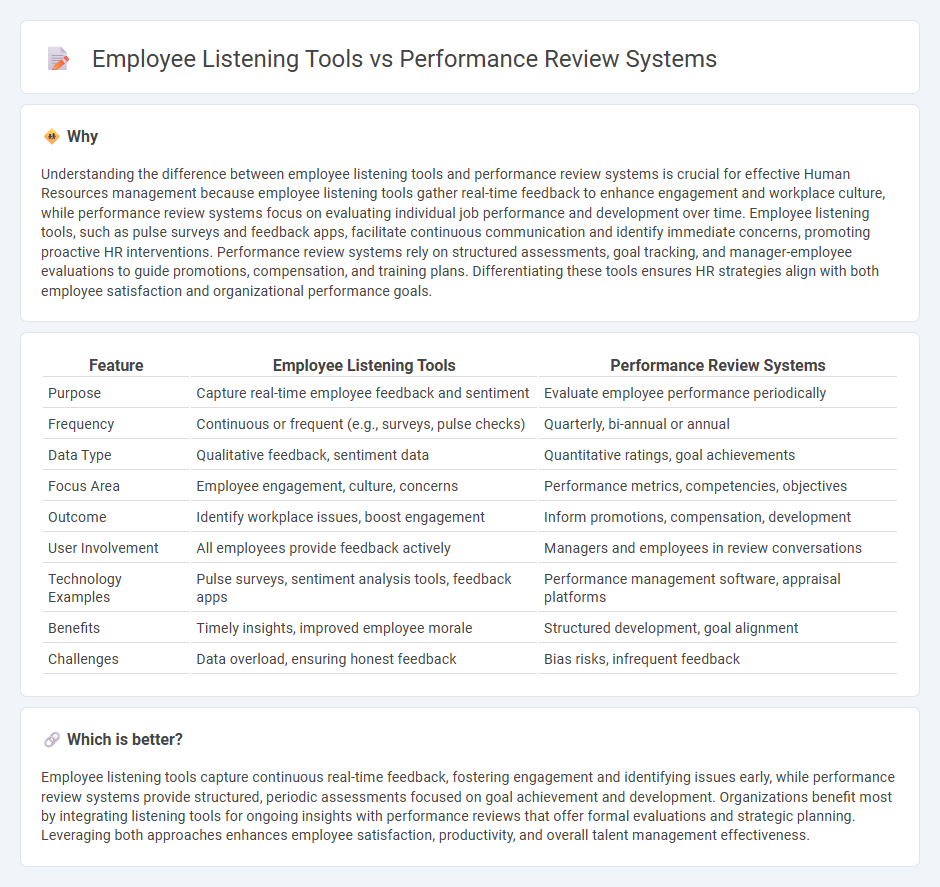
Employee listening tools capture real-time feedback and sentiment through surveys, pulse checks, and communication platforms, enabling continuous engagement and cultural insights. Performance review systems focus on evaluating employee achievements, goals, and development during scheduled appraisal cycles to guide career growth and organizational objectives. Discover how integrating both tools can enhance workforce management and boost productivity.
Why it is important
Understanding the difference between employee listening tools and performance review systems is crucial for effective Human Resources management because employee listening tools gather real-time feedback to enhance engagement and workplace culture, while performance review systems focus on evaluating individual job performance and development over time. Employee listening tools, such as pulse surveys and feedback apps, facilitate continuous communication and identify immediate concerns, promoting proactive HR interventions. Performance review systems rely on structured assessments, goal tracking, and manager-employee evaluations to guide promotions, compensation, and training plans. Differentiating these tools ensures HR strategies align with both employee satisfaction and organizational performance goals.
Comparison Table
| Feature | Employee Listening Tools | Performance Review Systems |
|---|---|---|
| Purpose | Capture real-time employee feedback and sentiment | Evaluate employee performance periodically |
| Frequency | Continuous or frequent (e.g., surveys, pulse checks) | Quarterly, bi-annual or annual |
| Data Type | Qualitative feedback, sentiment data | Quantitative ratings, goal achievements |
| Focus Area | Employee engagement, culture, concerns | Performance metrics, competencies, objectives |
| Outcome | Identify workplace issues, boost engagement | Inform promotions, compensation, development |
| User Involvement | All employees provide feedback actively | Managers and employees in review conversations |
| Technology Examples | Pulse surveys, sentiment analysis tools, feedback apps | Performance management software, appraisal platforms |
| Benefits | Timely insights, improved employee morale | Structured development, goal alignment |
| Challenges | Data overload, ensuring honest feedback | Bias risks, infrequent feedback |
Which is better?
Employee listening tools capture continuous real-time feedback, fostering engagement and identifying issues early, while performance review systems provide structured, periodic assessments focused on goal achievement and development. Organizations benefit most by integrating listening tools for ongoing insights with performance reviews that offer formal evaluations and strategic planning. Leveraging both approaches enhances employee satisfaction, productivity, and overall talent management effectiveness.
Connection
Employee listening tools capture real-time feedback, enabling Human Resources to identify strengths and areas for improvement that directly inform Performance Review systems. Integrating continuous feedback with structured performance evaluations creates a comprehensive understanding of employee engagement and productivity. This connection empowers HR to tailor development plans and enhance overall organizational performance.
Key Terms
360-Degree Feedback
Performance review systems primarily assess employee achievements and development needs through periodic evaluations, often leading to formal appraisal outcomes. Employee listening tools emphasize continuous feedback collection, capturing real-time sentiments and fostering a culture of open communication. Explore how integrating 360-degree feedback within these frameworks can enhance performance insights and employee engagement.
Pulse Surveys
Performance review systems primarily provide structured evaluations of employee performance over set periods, often resulting in formal feedback and development plans. Employee listening tools, such as pulse surveys, offer real-time insights into employee engagement and sentiment, enabling organizations to address concerns promptly and improve workplace culture. Explore how integrating pulse surveys with performance reviews can enhance continuous feedback and employee satisfaction.
Key Performance Indicators (KPIs)
Performance review systems primarily evaluate Key Performance Indicators (KPIs) through periodic assessments, offering structured feedback on goal achievement, productivity metrics, and competency benchmarks. Employee listening tools capture real-time feedback and sentiment analysis, providing dynamic insights into employee engagement and performance-related issues affecting KPI outcomes. Explore how integrating both systems can enhance holistic performance management and optimize KPI tracking effectively.
Source and External Links
12 Best Employee Performance Review Software & Tool in 2025 - Covers tools like Profit.co with AI-driven real-time insights and 360-degree feedback, and PerformYard with customizable review cycles and flexible feedback options, suited for various industries and team sizes.
Performance Management Software | Employee Performance Reviews - Describes Paycom's mobile-friendly software that streamlines performance reviews with customizable frequency, two-way conversations, 360-degree reviews, and goal-setting features to support continuous employee development.
How to Choose Performance Review Software - Explains different appraisal techniques supported by performance management software such as performance rankings, rating scales, regular check-ins, and real-time feedback for effective, bias-reduced employee evaluations.
 dowidth.com
dowidth.com